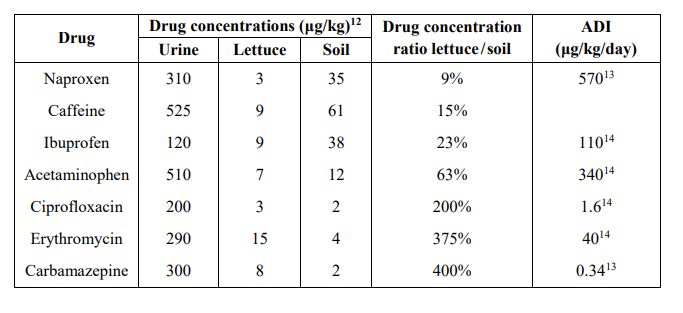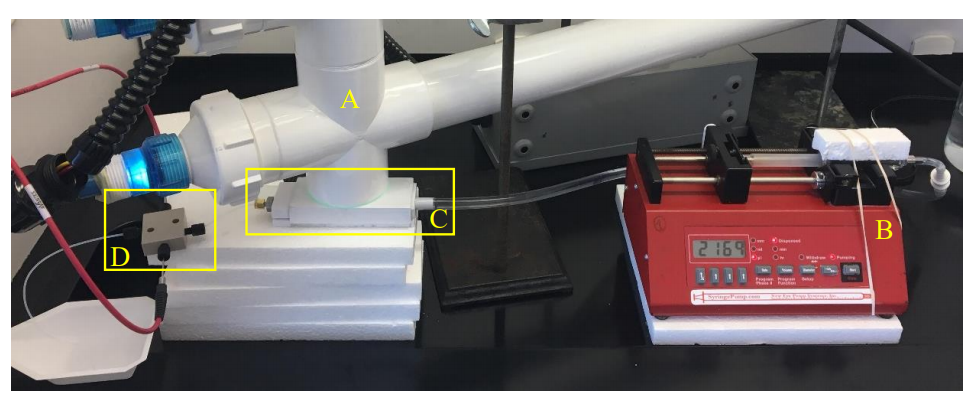In ‘Ultraviolet photolysis of acetaminophen in a 3D printed continuous flow reactor,’ thesis student John Goetze is not only exploring the benefits of urine as fertilizer but also experimenting with 3D printing devices that could be used in the field to pinpoint degradation of chemicals like pharmaceuticals that are harmful to agriculture. While many consumers may be leery about their potential food supply being sprayed with a supply of urine from the public, even worse would be ingesting the surprising amounts of unmetabolized pharmaceuticals. Degradation of residual medications could render the use of urine as a possibility, however.
 Farmers rely on fertilizers rich in nitrogen, phosphorus, and potassium (NPK) to encourage the growth of healthy plants. Human urine contains all these nutrients, and especially phosphorus. Goetze explains that numerous studies have shown that while phosphorus is necessary to many different applications, it is expected to be depleted in as little as 50 years.
Farmers rely on fertilizers rich in nitrogen, phosphorus, and potassium (NPK) to encourage the growth of healthy plants. Human urine contains all these nutrients, and especially phosphorus. Goetze explains that numerous studies have shown that while phosphorus is necessary to many different applications, it is expected to be depleted in as little as 50 years.
“Phosphorus is the most important of NPK when considering urine for its fertilizer value. Source separation of urine maximizes its value for fertilizer. Obtaining phosphorus from wastewater is more difficult, as it is diluted and possibly contaminated with other materials auxiliary to those in urine. Widespread source separation in developed countries would require retrofitting of current sanitation facilities,” states Goetze.
Pharmaceuticals do present an issue, however, posing ‘ecotoxicological risk,’ mainly by NSAIDs, antibiotics, and carbamazepine. And while much of the benefits of prescribed (or not) drugs are metabolized, large portions may still be left to pass through the urine.

The concentration of selected drugs in the general population sourced urine and drug concentrations in lettuce and soil after urine was added to field plots.
For the purposes of this study, Goetze used acetaminophen, which is also commonly referred to as paracetamol. The author used this over-the-counter pain reliever for the following reasons:
- Measured consistently in wastewater
- Easy to obtain
- Can be measured with UV spectroscopy
- Absorbs UV light
 For this research, the author used Kroger 500 mg acetaminophen caplets. They were crushed and mixed with deionized water, then stirred and heated, until the solution was diluted enough for analysis. Aqueous acetaminophen concentrations were chosen at 2.5 ppm, with the consideration that previous research shows urine from public events measuring 0.5 ppm.
For this research, the author used Kroger 500 mg acetaminophen caplets. They were crushed and mixed with deionized water, then stirred and heated, until the solution was diluted enough for analysis. Aqueous acetaminophen concentrations were chosen at 2.5 ppm, with the consideration that previous research shows urine from public events measuring 0.5 ppm.
Goetz 3D printed most of the parts (nine, in total) for the continuous flow reactor, designing them in SOLIDWORKS and then using a MakerBot Replicator 2 FDM printer with PLA.
“Trials showed that more acetaminophen is degraded as residence time and light intensity increase. Continuous flow reactor performance is comparable to MFR and PFR idealized models with respect to residence time. Data corresponds more closely to the ideal reactor models as light intensity decreases. Pseudo-first order rate constants (k’) were determined using a best fit of MFR and PFR models to the data at each separate intensity. Rate constants increased linearly with light intensity,” concluded the author.
Up to 80 percent of the acetaminophen was degraded in the experimental conditions of the continuous flow reactor. This demonstrates that levels of the pharmaceutical can be significantly reduced via UV photolysis. The reactor design can be easily scaled up, since the specialized components can be produced quickly with 3D printing. Artificial light sources producing an intense 254 nm wavelength are commonly available on the consumer market. The lack of catalysts and oxidizers reduces costs and eliminates some materials access barriers. The reactor, artificial light, and pump apparatus can be applied quickly and cost-effectively in laboratory or industrial settings. The photolysis data from this study can inform the design of future applications.”

Experimental apparatus for continuous flow trials. Equipment includes 254 nm light source (A), syringe
pump (B), 3D printed reactor (C), and UV-vis flow cell (D).
3D printing has been connected with innovation in diagnostic devices due to the ease in design and production, and affordability in manufacturing—especially in the medical field, from innovations for detecting cancer to malaria and even tuberculosis. What do you think of this news? Let us know your thoughts! Join the discussion of this and other 3D printing topics at 3DPrintBoard.com.
[Source / Images: ‘Ultraviolet photolysis of acetaminophen in a 3D printed continuous flow reactor’]
Subscribe to Our Email Newsletter
Stay up-to-date on all the latest news from the 3D printing industry and receive information and offers from third party vendors.
You May Also Like
3D Printing Unpeeled: Biofuel Waste to Filament & Sustainable Photopolymers
I can’t ever remember a day with so many potentially high impact news stories have come out. In one story, we all know that there are problems with the safety...
Finnair Hires AM Craft to 3D Print Plastic Parts for Aircraft Interiors
Riga-based AM Craft, a supplier specialized in 3D printing aviation components and certified under EASA Part 21G, announced a significant achievement today. The company will assist in upgrading Finnair’s A320...
3DPOD Episode 198: High Speed Sintering with Neil Hopkinson, VP of AM at Stratasys
Neil Hopkinson, a pioneering 3D printing researcher, played a pivotal role in developing a body of research that is widely utilized today. He also invented High Speed Sintering (HSS), also...
3D Printing Webinar and Event Roundup: May 12, 2024
Webinars and events are picking up in the AM industry this week! ASTM International continues its Professional Certificate Course and Stratasys continues its advanced in-person trainings, while 3D Systems is...
































